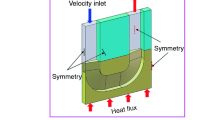Abstract
Blow moulding is one of the most important polymer processing technologies to produce hollow-shaped parts at a short time. The cooling stage takes up approximately two thirds of the complete blow moulding cycle. It becomes the major factor to determine the productivity and the quality of the blow-moulded part. The cooling time and the quality part are controlled by an adequate cooling channel design inside the blow mould. Inappropriate cooling channel design will increase the cooling time after part ejection. Recently, the success of integrating conformal cooling channel (CCC) design in the injection moulding process has been proven by different research publications and practices. The merit of the applications of CCC can also be extended to the existing blow moulding process. In this study, an effective design method is proposed for integrating CCC into the blow mould with the aid of computer-aided design and analysis tools. The fabrication of integrating CCC into the blow mould by rapid tooling technology is explored. Computer-aided engineering simulation is employed to verify the cooling performance of the CCC corresponding to the blow mould surface geometry. The analysed results are compared with those using the traditional straight line-drilled cooling channel (SLDCC) used in the blow moulding process. The results indicated that the cooling time and temperature uniformity of the blow-moulded part can be effectively improved. The proposed CCC design has a shorter cooling time and a lower part temperature than the SLDCC one.
Similar content being viewed by others
References
Lee NC (2008) Blow molding design guide. Hanser, Munich
Custompartnet (2010) website: www.custompartnet.com/wu/blow-molding. Accessed 30 May 2012
Rosato DV, Rosato AV, DiMattia DP (2004) Blow moulding handbook, 2nd edn. Hanser, Munich
Sprackling MT (1993) Heat and thermodynamic. Macmillan, New York
Agazzi A, Sobotka V, Le Goff R, Garcia D, Jarny Y (2010) A methodology for the design of effective cooling system in injection moulding. Int J Mater Form 3(1):13–16
Cho YJ, Ryu KY, Lee SW (2007) A study on automatic design system for a blow mould, ICCSA 2007, LNCS 4707, Part 3, 11-19
Bendada A, Erchiqui F, Kipping A (2005) Understanding heat transfer mechanisms during the cooling phase of blow molding using infrared thermography. NDT E Int 38(6):433–441
Gao DM, Nguyen KT, Hetu JF, Laroche D, Garcia-Rejon A (1998) Modeling of industrial polymer processes: injection molding and blow molding. Adv Perform Mater 5(1–20):43–64
Attar A, Bhuiyan N, Thomson V (2008) Manufacturing in blow molding: time reduction and part quality improvement. J Mater Process Tech 204:284–289
Schmidt FM, Agassant JF, Bellet M, Desoutter L (1996) Viscoelastic simulation of PET stretch/blow molding process. J Non-Newtonian Fluid Mech 64:19–42
Giannopapa CG (2006) Development of a computer simulation model for blowing glass containers. ASME, 10th International Symposium on Emerging Technology in Fluids, Structures and Fluid-Structure Interactions PVP2006, Vancouver, BC, Canada, PVP2006-ICPVT11-93262
ANSYS POLYFLOW (2011) website: http://www.ansys.com/Products/Simulation+Technology/Fluid+Dynamics/ANSYS+Polyflow. Accessed 28 Jun 2012
Aaccuform B-Sim (2011) website: http://www.t-sim.com/WebPages/EN/ProductBSIM.html. Accessed 28 Jun 2012
Abaqus/Explicit (2011) website: http://www.3ds.com/products/simulia/portfolio/abaqus/overview/. Accessed 28 Jun 2012
LS-DYNA (2011) website: http://www.lstc.com/products/ls-dyna. Accessed 2 July 2012
AutoDesk Moldflow (2011) website: http://usa.autodesk.com/moldflow/. Accessed 2 July 2012
Li CL (2001) A feature-based approach to injection mould cooling system design. Comput Aided Des 33(14):1073–1090
Li CL, Li CG, Mok ACK (2005) Automatic layout design of plastic injection mould cooling system. Comput Aided Des 37(7):645–662
Hopkinson N, Dickens P (2000) A comparison between stereolithography and aluminium injection moulding tooling. Rapid Prototyp J 6(4):253–258
Sachs E, Wylonis E, Allen S, Cima M, Guo H (2000) Production of injection molding tooling with conformal cooling channels using the three dimensional printing process. Polym Eng Sci 40(5):1232–1247
Xu X, Sachs E, Allen S (2001) The design of conformal cooling channels in injection molding tooling. Polym Eng Sci 41(7):1265–1279
Ferreira JC, Mateus A (2003) Studies of rapid soft tooling with conformal cooling channels for plastic injection moulding. J Mater Process Technol 142(2):508–516
Dimla DE, Camilotto M, Miani F (2005) Design and optimisation of conformal cooling channels in injection moulding tools. J Mater Process Technol 164–165:1294–1300
Zhang DQ, Cai QZ, Liu JH, Zhang L, Li RD (2010) Select laser melting of W–Ni–Fe powders: simulation and experimental study. Int J Adv Manuf Technol 51(5–8):649–658
Song B, Dong SJ, Liao HL, Coddet C (2012) Process parameter selection for selective laser melting of Ti6Al4V based on temperature distribution simulation and experimental sintering. Int J Adv Manuf Technol. doi:10.1007/s00170-011-3776-6
Dadbakhsh S, Hao L, Sewell N (2012) Effect of selective laser melting layout on the quality of stainless steel parts. Rapid Prototyp J 18(3):241–249
Kruth JP, Levy G, Klocke F, Childs THC (2007) Consolidation phenomena in laser and powder-bed based layered manufacturing. CIRP Ann Manuf Technol 56:730–759
Matin I, Hadzistevic M, Hodolic J, Vukelic D, Lukic D (2012) A CAD/CAE-integrated injection mold design system for plastic products. Int J Adv Manuf Technol. doi:10.1007/s00170-012-3926-5
Li CL, Yu KM, Lee YH (2006) Automatic datum dimensioning for plastic injection mould design and manufacturing. Int J Adv Manuf Technol 28(3–4):370–378
Au CK (2007) A meshless method for predicting two dimensional flow front advancement and its application in injection moulding. Int J Adv Manuf Technol 34(1–2):62–69
Chen CC, Su PL, Lin YC (2009) Analysis and modeling of effective parameters for dimension shrinkage variation of injection molded part with thin shell feature using response surface methodology. Int J Adv Manuf Technol 45(11–12):1087–1095
Chan WM, Yan L, Xiang W, Cheok BT (2003) A 3D CAD knowledge-based assisted injection mould design system. Int J Adv Manuf Technol 22(5–6):387–395
Chan IWM, Pinfold M, Kwong CK, Szeto WH (2011) A review of research, commercial software packages and patents on family mould layout design automation and optimization. Int J Adv Manuf Technol 57(1–4):23–47
Author information
Authors and Affiliations
Corresponding author
Rights and permissions
About this article
Cite this article
Au, K.M., Yu, K.M. Conformal cooling channel design and CAE simulation for rapid blow mould. Int J Adv Manuf Technol 66, 311–324 (2013). https://doi.org/10.1007/s00170-012-4326-6
Received:
Accepted:
Published:
Issue Date:
DOI: https://doi.org/10.1007/s00170-012-4326-6




